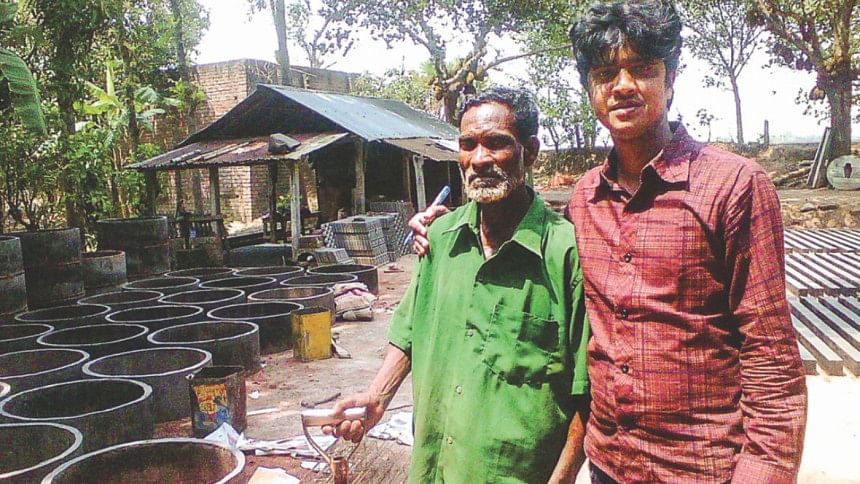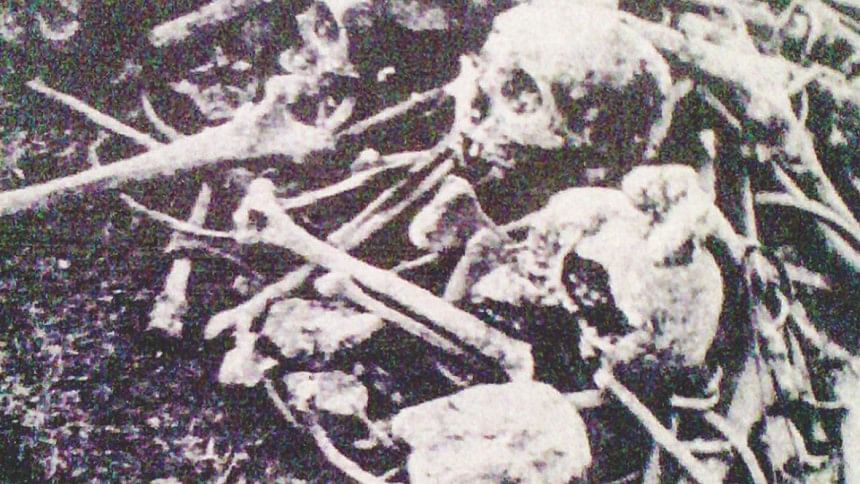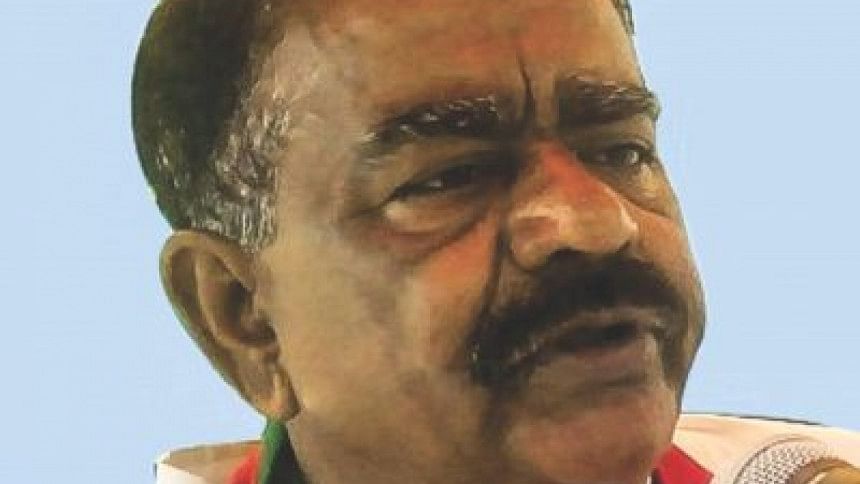Alamdanga killing field could have more to say

The Pakistan army's killing field in Alamdanga of Chuadanga could be holding further proof of the brutality of the anti-liberation forces.
Even now, nearly 45 years after the war, evidence of the brutality is literally being unearthed.
The Pakistan occupation force used to stop trains near the railway bridge under Alamdanga Police Station on a regular basis during the nine-month-long war. They forced people down and killed about 2,000 men and women. They then dumped the bodies inside the compound of the nearby Water and Power Development Authority (Wapda) building and two other killing fields, witnesses and locals said.
Noted freedom fighter of Alamdanga Sobed Ali and 70-year-old farmer Abul Hossain of Kamalpur had witnessed the mass killings.

Abul said the Pakistan army killed about 1,000 men and women and dumped the bodies on the land he owns.
Several others, including local elders Ali Asgar and Chhoko Ali, said in the first week of January, 1972, the killing field near the rail bridge, popularly known as Lal Bridge, was excavated and skulls and bones of 400 people were found. Photographs were taken.
However, about 1,000 more victims' remains are still lying there, they claimed.

If the killing fields in Alamdanga were excavated properly, remains of around 2,000 martyrs could be recovered. It would uncover a mass grave and add further proof of the brutality of the anti-liberation forces, locals claimed.
Locals said during the war, the Pakistan army stop the trains near the fish market beside Alamdanga rail bridge.
They confined the women to the Wapda shed and army officers raped them in the Wapda Division Bungalow. When they were done with the women, they sent them to a torture cell near the bridge and the women were later killed. Their bodies were dumped in the field.
They forced the men to dig the pit in the killing field. They killed the men too and dumped them in the pit.
A signboard in the locality mentions that Pakistan army Major Rana, Capt Naqvi and havildar Enayet led the acts of genocide.

Abul said Pakistan army havildar Enayet used to sharpen the ends of bamboo poles and killed people by using those as bayonets and that he had seen about 20 people being killed this way.
There is another killing ground in an orchard north of the bridge where a few hundred people were killed and dumped.
Recently, the killing ground had been excavated and a mausoleum was built there.

The Pakistan army had killed about 2,000 people between the last week of June and December 7 of 1971. When the ground was dug up in early January 1972, locals could not identify the victims. The relatives had to return disappointed.
Freedom fighter M Sobed Ali said human remains are still found when farmers plough their fields near the killing ground. When the earth is dug, skulls, torn clothes of children, and pieces of saris are found. Gold ornaments like rings or earrings are also found. The soil of Alamdanga still testifies to the genocide committed by the Pakistan forces, he said.
In the last week of December 1971, a committee comprising local freedom fighters and Awami League leaders excavated the area and found skeletons. This was reported in Bangla daily Janakantha in 1999.
THE TESTIMONIES
Abul Hossain said when a Bangalee was shot by the Pakistan army one day, the man screamed in pain. It was beyond words. Muslim women begged the troops in the name of Allah and the Prophet to spare their lives but it did not help.
The troops tortured and killed Bangalees in the most barbaric way. They did not show an iota of kindness.
They forced Abul to dig pits. He said he knew many who were taken there were to be killed.

He said, "I find no words to describe those. The person we used to call Gun Miar Baap became the Peace Committee chairman. Another became the secretary. Mugu and Hares had to cook for the troops in the camp. I was the youngest of them all, so I had to work as an assistant to them.
In exchange, they gave me Tk 2 a day and rice gruel. I tried to provide information to the known freedom fighters as much as possible."
Abul described his experience of one day.
"We were taken to the killing field near the bridge. We had been hearing screams of frightened people. Peace Committee chairman Yusuf Miah and a member was present. A day later I had to dig two pits. One of the collaborators ordered me to throw the body of a person into the pit. It seemed to me that I was the undertaker. I had to throw the body into the pit. I felt dizzy. Some people were screaming behind me. Some of them were begging for life. I worked for 15 or 16 days in such a situation."
Freedom fighter Saiful Islam Bepari said one day he was taken by the Pakistan army men and their local collaborators to the Lal Bridge. He said they kept him standing in chest-deep water of a canal near the bridge for half a day. His body felt numb.
He then saw two people getting whacked in the head with a blunt object and thrown into a pit. The pit was then filled with dirt.
Bepari said the Pakistan army men selected Bangalees from the trains that they stopped near the bridge. They did this with the help of some Bangalee collaborators. Each time, they brought 30 to 40 people down.
The beautiful women were taken away. Others were forced to dig pits. The victims were thrown into the pits after they were delivered with an axe or iron-rod blow. Some were bayoneted.
Bepari said he was spared since a peace committee member, known as "Butcher Ibrahim", knew him and told his cohorts to let him go.
Bepari said after the Pakistan army had fled, they with the help of people detained a number of Razakars. Some of them were pardoned, some could not be traced.
Some of them are still around untouched.
Freedom fighter and former municipal mayor M Sobed Ali said the Pakistan army following the advice of Razakars, Al-Badr and Peace Committee men set up two camps on the two banks of Kumar river beside the Lal Bridge.
The Razakars and Urdu-speaking young men frequented the camps. Trains were stopped there and passengers were brought down.
The Pakistan army men used to ask whether they could recite the "Kalema". If anybody could not satisfy them, they were killed by kicking or beating with rifle butts.
The bodies were dumped near the Lal Bridge. Black uniformed militias also joined Pakistani troops. People said many women were taken to the army camps, raped and killed.

One day some people of Paikpara were forced to dig pits and when it was completed, the Pakistani troops hit one of the men's head with a spade and threw him into the pit. They then covered it with dirt.
But the victim was not dead. He regained consciousness at night and was able to burrow out. He then swam across the Kumar river to his village and was able to return to normal life after treatment.
Following locals' demand, the government completed construction of a mausoleum as part of its initiative to preserve Alamdanga killing field.
Bushes in the area have been cleared and flower gardens have been made. A number of concrete benches have been placed on four sides of the killing field.
A board displaying important information about the Liberation War and the killing field has been erected. An archive has also been set up at there.

 For all latest news, follow The Daily Star's Google News channel.
For all latest news, follow The Daily Star's Google News channel. 



Comments